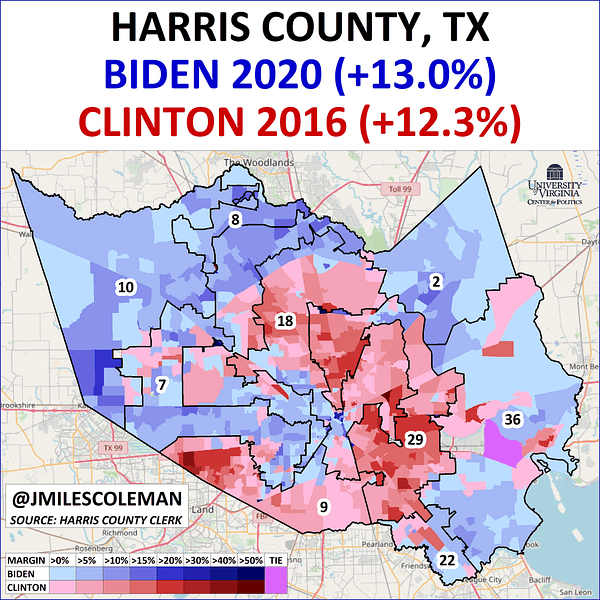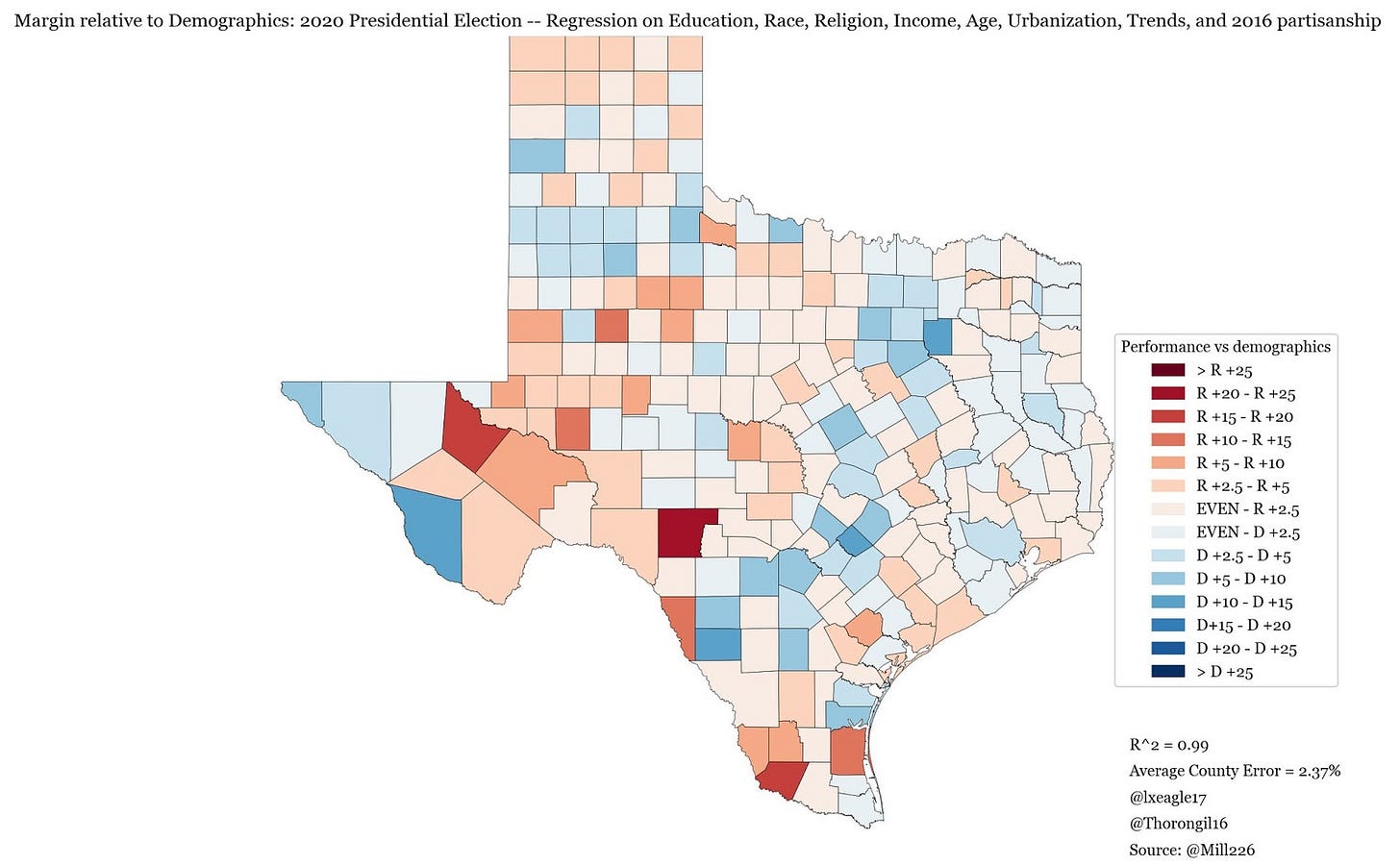Will Texas be competitive in 2022?
In some ways, this is the most important question of the 2022 midterms, but it's a question I've mostly nibbled around the edges of, because, well, I don't know. Is some of my reluctance that I've very publicly been burned by believing in Democratic Texas? Obviously, and I'd be lying if I said I wasn't still facing some amount of internal doubt and fear because of my past. That said, that sort of analysis - paralysis based on the fact that I know I will piss people off writing about Texas - is cowardice, so let's talk about the Lone Star State.
…
"If turnout in Harris County goes from, what was it, 1.3M to 1.7M, who's going to be that marginal voter from 1.3M to 1.7M, who votes this year and didn't in 2016? Low propensity Hispanics."
This is a real quote (or, a very, very close paraphrase) that I said the week before the November election. I can't admittedly remember whether I said it on a podcast or just in real life conversation, but either way, that's a thing that I said. And every single part of that was right, except I cut the quote off early.
"And, I mean, they're not going to vote for Trump, come on now."
Imagine being this close to getting the point, and then just… not. Imagine being so sharp about what the turnout changes meant, and then just completely and utterly fucking up the analysis part of that equation.


This helpful map of Houston, from J Miles Coleman of Sabato's Crystal Ball, shows the story of how wrong I was. All the white areas, like George HW Bush's Texas 7th and Dan Crenshaw's Texas 2nd, trended heavily blue. All the Hispanic heavy areas trended heavily to Trump, as did South Texas. Why? Because low propensity Hispanics voted like low propensity voters, not Hispanics.
In every other country on earth, I get the notion that low propensity, culturally conservative voters are trending right. I got this in the UK, where I predicted a sizable Tory majority in 2019 and was validated. I even got it in the context of the US, where I never really bought the idea that Democrats would do particularly well in Missouri or Indiana, despite occasional polls saying so. I got it in Canada too, although it's less of a problem because so much of our population is in cities. And yet, because the low propensity voters weren't white, I just assumed they'd stay Democratic.
At the same time as I believed well-off white social liberals would vote more based on their social liberalism than their well-off whiteness, I believed culturally conservative Hispanics would vote on the basis of their skin colour and not their cultural conservatism. If that trade off seems hypocritical or wishcast-y, well, it was, and I got smashed because of it. In 2022, I'm not going to.
…
There is no viable road back to the kinds of results that Hillary Clinton got amongst Hispanics in Texas.
I know, I know, it was only four years ago, but it's not coming back. Hell, I'm not sure we can get back to Beto's (good, but not even close to Hillary level) numbers.
Take a gander at some of those South Texas counties, and you'll see the extent of the slippage. Webb County went from Clinton +51 to Beto +43 to Biden +23, a border county that the 2015 Texas Population Estimate Program said was 96% Hispanic. Go up the border a bit and you hit Val Verde, a Clinton +8, Beto +5, Trump +10 county where about 75% of voters are Hispanic. We can keep this up, but you get to this point where the damage is huge. It even hit areas like Houston, but the dueling coalitions made it look like a wash, as Coleman's very helpful map shows. Why did it happen? Because culturally conservative, religious voters didn't want to vote for the Vice President whose admission that he had moved on gay marriage forced Obama to say he was also for it. Joe Biden himself may be a social moderate, but he said that if the Supreme Court overturned Roe, that he would support passing the rights enshrined by Roe in federal legislation. Why are we supposed to pretend that older Catholics would like that kind of messaging?
Yes, some of the slippage can be gotten back, I'm sure, by door knocking and better messaging, but in high turnout elections, these voters aren't coming back - unless the Democratic Party abandons their social liberalism, which they won't do, and also shouldn't do as a matter of electoral politics either - Georgia was only won because of socially liberal whites being willing to swing our way.
But here's the thing - a lot of that slippage should have been expected. This map, courtesy of Lak, tells a different tale - one where Democrats underperformed in heavily Hispanic areas like Webb or Val Verde, but not terribly so. There is some amount of this which is reversible, but most of it isn't. Pretending that's not the case is just risible nonsense.
But what Lak's model also shows is the way that Texas will be competitive next - through the white (or, more clearly, whiter) cities, like Dallas and Austin. You can see the quad of counties in the DFW - Dallas, Tarrant, Collin, and Denton - and you can see it in the Austin suburbs. Hays, directly south of Austin proper, has gone from Trump +3 to Biden +11 in four years. Unfortunately for aspirations many of us had, it was Beto +15 in 2018. And that's where the crux of the battle over 2022 comes.
…
I'm assuming it will be Greg Abbott versus Beto O'Rourke at this point, based on publicly available information and reporting. That could well be wrong, but that is my assumption currently. Who will win? Abbott, if you put a gun to my head right now. I have the race Lean Republican. I will repeat that for the people who want to misrepresent me - I have the race Lean Republican. Not Tossup, not Lean Democratic. I have it Lean Republican. That said, I'm not at all sure about that.
The Hispanic problems that Democrats faced were in large parts failures caused by record turnout propelled by the singular force of nature that is Donald Trump. Or, I should say, was Donald Trump. Even without him on the ballot, but still in office, Republicans were never able to get their voters out to the same degree. They didn't in Virginia in 2017, they didn't in the midterms, they didn't in the 2019 Governors races, and they didn't in Georgia in January. There is little reason to expect them to turn out in 2022, which will make the electorate more full of whites in places like Southlake than, say, three counties west. It is an electorate that will be more socially liberal, as it was in Georgia, and where the Hispanics are more favourable to us, because the Trumpy, low propensity ones don't show up - again, like in Georgia.
The path to Democratic victory relies not on the South of the state, although that will alleviate some of our issues - it runs through Austin, the DFW, and the white parts of Houston. It runs through Crenshaw's district and the 7th and the quad, it runs through Tarrant and Hays, not Starr and Webb. It runs through an economic messaging that isn't about bashing the rich for the sake of it, but of fairness. It runs through Southlake, and people who cannot fathom trading away their social liberalism for tax cuts anymore.
Blue Texas doesn't need us winning Hispanics by 40%, which is what Beto did in 2018. We don't need that to win, but we do need better than the 25% Biden won by. A lot of that work will be done by turnout in 2022, if Georgia's lessons hold, and increased canvassing and attention should make their differences on the margins. But if O'Rourke can build on his 2018 results, and the gains in 2020, with well-off white social liberals, then you're starting to see how it could happen.
For so much of 2020, I was beating the drum that there was no Democratic Hispanic problem, and I was completely, utterly, unabashedly wrong. There was a huge problem, but at this point I'm quite sure there's not much that can be done. Blue Texas will come, and soon, even if I currently think it will take longer than 2022. But if Beto wins, don't be surprised when his coalition looks a lot different than it did even in 2018.

